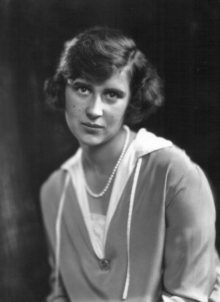Alžběta Řecká a Dánská
| Alžběta Řecká a Dánská | |
|---|---|
| hraběnka z Törring-Jettenbachu | |
 princezna Alžběta, 1924 | |
| Narození | 24. května 1904 Tatoi, Řecké království |
| Úmrtí | 11. ledna 1955 (50 let) Mnichov, Bavorsko |
| Pohřbena | Winhöring |
| Sňatek | 10. ledna 1934 |
| Manžel | Karel Teodor z Törring-Jettenbachu |
| Potomci | Hans Veit z Törring-Jettenbachu Helena z Törring-Jettenbachu |
| Dynastie | Glücksburkové |
| Otec | Mikuláš Řecký a Dánský |
| Matka | Elena Vladimírovna Ruská |
| Některá data mohou pocházet z datové položky. | |
Alžběta Řecká a Dánská (24. května 1904 Tatoi – 11. ledna 1955 Mnichov) byla prostřední dcera prince Mikuláše Řeckého a velkokněžny Eleny Vladimírovny Ruské.
Život
Dětství
Alžběta se narodila 24. května 1904 v paláci Tatoi v Řecku. Rodina jí pro její husté tmavé vlasy říkala 'Woolly'. Alžběta se věnovala jezdectví a malbě.
Její starší sestra Olga se v roce 1923 provdala za prince Pavla Karađorđeviće. Po zavraždění jeho bratrance krále Alexandra I. Karađorđeviće vládl Pavel v letech 1934 až 1941 jako regent Jugoslávie.
Alžbětina mladší sestra Marina se v roce 1934 provdala za prince Jiřího, vévodu z Kentu. Marinin nejstarší syn Eduard je stávajícím vévodou z Kentu a bratrancem královny Alžběty II.
Přes otce byla Alžběta a její sestry sestřenice prince Philipa, vévody z Edinburghu.
Manželství a potomci
Alžběta se 10. ledna 1934 provdala za hraběte Karla Teodora z Törring-Jettenbachu (22. září 1900 – 14. května 1967). Přes svou matku Žofii Adelaidu Bavorskou byl synovcem belgické královny Alžběty Gabriely a princezny Marie Gabriely Bavorské. Alžběta měla s Karlem Teodorem dvě děti, šest vnoučat a sedmnáct pravnoučat. Jejich dětmi byli:
- 1. Hans Veit Kašpar Mikuláš z Törring-Jettenbachu (* 11. 1. 1935 Mnichov), manž. 1964 Henrietta z Hohenlohe-Bartensteinu (* 23. 8. 1938 Bartenstein)[1]
- 2. Helena Marina Alžběta z Törring-Jettenbachu (* 20. 5. 1937 Winhöring), manž. 1956 Ferdinand Habsbursko-Lotrinský (6. 12. 1918 Vídeň – 6. 8. 2004 Ulm)[2]
Alžběta zemřela 11. ledna 1955 v Mnichově na rakovinu. Bylo jí 50 let.
Tituly, oslovení a vyznamenání
Tituly a oslovení
- 24. května 1904 – 10. ledna 1934: Její královská Výsost princezna Alžběta Řecká a Dánská
- 10. ledna 1934 – 11. ledna 1955: Její královská Výsost princezna Alžběta, hraběnka z Törring-Jettenbachu
Vyznamenání
- Řád svaté Olgy a Žofie
Vývod z předků
Reference
V tomto článku byl použit překlad textu z článku Princess Elizabeth of Greece and Denmark na anglické Wikipedii.
- ↑ Henriette, Prinzessin zu Hohenlohe-Bartenstein : Genealogics. genealogics.org [online]. [cit. 2023-05-09]. Dostupné online.
- ↑ Ferdinand, Archduke of Austria : Genealogics. genealogics.org [online]. [cit. 2023-05-09]. Dostupné online.
Externí odkazy
 Obrázky, zvuky či videa k tématu Alžběta Řecká a Dánská na Wikimedia Commons
Obrázky, zvuky či videa k tématu Alžběta Řecká a Dánská na Wikimedia Commons
Média použitá na této stránce
Coat of arms of the Kingdom of Greece in 1936–1973
- Royal Coat of Arms of Greece under the Glücksburg dynasty, created after the restoration of King George II to the throne in 1935, to the exile of King Constantine II in 1967 and finally until the abolition of the monarchy in 1973.
- The Escutcheon features the white cross on a dark blue field of Greece. The Inescutcheon features the Arms of the Greek line of the House of Schleswig-Holstein-Sonderburg-Glücksburg. The shield is then topped with a golden Royal Crown.
- It features an escutcheon divided by the red and white cross of the Order of the Danneborg, the first quarter features the arms of Denmark (three crowned blue lions and nine hearts in yellow field). The second of Schleswig (two blue lions passant in yellow field). The third divided into four; the chief features the three royal crowns in blue field of the Kalmar Union, the second half with a crowned stockfish on red field of Iceland and the last half divided between the ram of the Faroe Islands and a polar bear of Greenland, both on blue fields. The fourth quarter is divided between two halves, the chief depicts a yellow field with a blue lion passant over nine red hearts of the King of the Goths, the lower half depicts a crowned golden lindorm on a red field of the King of the Wends.
- Upon it is another inescutcheon in red, divided into four quarters: the first a a silver nettle leaf of Holstein, the second the a swan with a golden crown of Stormarn, the third a knight dressed in golden armor on a silver horse of Dithmarschen and the fourth of a golden horse's head of Lauenburg.
- Upon it is another inescutcheon divided the first features the red and yellow bars of Oldenburg, the second a golden cross on a blue field of Delmenhorst.
- The escutcheon rests on a golden pedestal and supported by two human figures representing the Greek mythological hero Herakles (Heracles), holding a wooden club and wearing the skin of the Nemean lion.
- The escutcheon is surrounded by the ribbon and cross of the Order of the Redeemer, the cross depicts Christ Pantocrator, surrounded by the order's motto:"Η ΔΕΞΙΑ ΣΟΥ ΧΕΙΡ, ΚΥΡΙΕ, ΔΕΔΟΞΑΣΤΑΙ ΕΝ ΙΣΧΥΙ" or "Thy right hand, O Lord, is become glorious in power" from Exodus, 15:6.
- The motto of the Coat of arms and of the dynasty, depicted on a golden ribbon below the pedestal reads: "Ἰσχύς μου ἡ ἀγάπη τοῦ λαοῦ" or "The people's love, my strength"
- The coat of arms is then surrounded by a dark blue mantle and topped with another royal crown.
Autor: Sodacan, Licence: CC BY-SA 3.0
Royal arms of Denmark from 1972.
Her Royal Highness Princess Elizabeth of Greece and Denmark, later Countess zu Toerring-Jettenbach (1904-1955)


